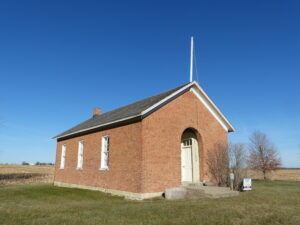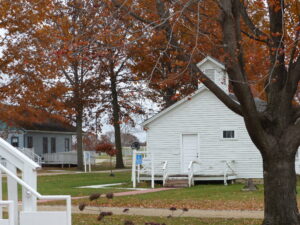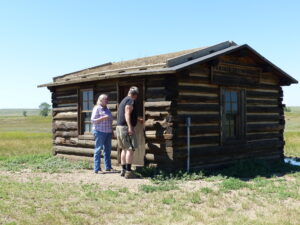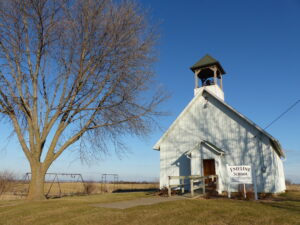One-Room School Houses
Readers’ Reminisce
Note: The original article appeared in the Cedar Rapids Gazette, Sunday, December 19, 2021. We invited readers to share their reminiscences and included here some that were in the original feature. We begin this blog with the background that was part of the Gazette feature.
Country Schools Across America
“For about a century after statehood (in Iowa), families, often with many children, lived on 160 acres in rural places. Although few kids went to college, parents valued learning and these schools were once the foundation of America’s free, public, education. Schooling in rural Iowa posed challenges. Depending on the season roads were either mud or dust with cars and school busses in the future. Towns were a distant trek, so one-room schools were built, usually within walking distance – two miles – of home.
“Often the sole teacher was an unmarried woman. What she taught was decided by the citizens of the township where the school was located. These teachers did many tasks, including teaching reading, writing, and math, sweeping the floor, and feeding wood into the potbellied stove. Some teachers even lived in the school! Others boarded with nearby families. That must have been something to teach kids all day and then board with them in the evening!
“A typical American one-room school featured George Washington and Abraham Lincoln’s portrait upfront, rows of wooden desks, a potbelly stove, and a privy or two outside. Although facilities were humble, pleasant memories linger in the minds of older people who launched their learning careers in tiny schools.
Fond Memories
“Several of our older friends attended one-room schools as children across the country and in Iowa. All remember funny incidents from the past and believe their school experiences launched them to success in many occupations.
““I remember the Veteran’s Day Blizzard of 1940. It was a beautiful morning but clouds rolled in as the wind picked up outside Flanagan School. We had a car by then, but my school was on a dirt road. Dad thought the car would founder in drifts but horses might get through. So, he picked me up with the team with the wind howling on the way home,” said John Regan who attended the one-room school between Holy Cross and Rickardsville in Dubuque County.
““My teacher was Miss Regan, Dad’s cousin. She was wonderful, and in that small building I learned education basics,” continued Regan. He went on to serve a successful hitch in the Army, repaired typewriters in New York City and became a John Deere equipment dealer in Newton, NJ. Before retiring he rose to executive VP of the company. John now lives in a New Jersey senior residence but often reminisces about his Iowa childhood.
Quality Depends on Cooperation
“Idahoan, Bob Pratt, Rich Patterson’s former college roommate, drawled, “I didn’t go to a one-room school. Mine was a two-roomer in rural Idaho. Grades one through four were in one room and five through eight in the other.” His school had but three employees: two teachers and a person who both cooked and cleaned. After eighth grade, Pratt attended a tiny high school and later earned a degree from the University of Idaho. During a long career in tiny high schools, he taught practical farming and mechanic skills and math and biology.
“Both Iowan Regan and Idahoan Pratt told us, “The education I received in tiny schools was superb. Maybe better than I’d have had in a big school. My classmates and I were well prepared for life and led successful careers in many areas.” Pratt continued, “I taught in high schools with just a few students in each graduating class, but they went on to great success. One is a cardiac surgeon. Another is a skilled cabinet maker. It’s the quality of the teachers and the cooperation of parents that make students excel, not the size of the school,” he emphasized.
Antics and Airplanes
One friend recalled her mother getting a piggyback ride to school after losing her boots in the mud. Pam Tegler Geraghty, a retired Cedar Rapids special education teacher, admits to being a “holy terror!” as a kid at the Lamont, IA, school in the 1950s. She slopped in a creek on the way home and once locked a classmate in the outhouse.
Pat Maas, a retired teacher and health secretary at Cedar Rapids’ Grant Wood Elementary, remembers rushing outside to watch an airplane zoom overhead when planes were a new wonder.
- We sat on the stoop of took in the memories of by-gone days.
- Ushers Ferry village complete with a school.
Quite the Career
Jack Neuzil of Solon, Iowa, reminisced about his country schooling days back in the mid-1930s. “I remember the first day the hired man took me on horseback.” After that, he and the other kids walked to school.
Practicing Life-Long Skills of Helping as Needed and Sanitation
Kids picked up sticks for the woodstove, pumped water from the well and used a dipper to drink from, and clapped chalk dust off erasers outside. They practiced sanitation. After using the outhouse, they would wash their hands and dump the water outside.
Stories, Games, and Pranks
“We would sit around the teacher who would read stories,” Neuzil shared. Popular recess games were Annie-Annie Over (or Andy Andy Over) and Kick the Can. Kids showed their daring-do by balancing along the wooden fence. He chuckled that adults would guard the outhouse around Halloween to prevent pranks.
Into the Future
As Pratt and Regan shared, the quality of education can be high in country schools. After his couple of years in the one-room school with eight or nine kids, Neuzil attended the University of Iowa schools and on to college. “I didn’t realize how good a student I was until I went to Northern Illinois College.” Attending on a work-study plant, the equivalent of a basketball scholarship, he held a job in maintenance. “The head custodian respected my work so much he eventually had me clean the president’s office, “Neuzil reflected proudly.
Creative Career Paths
Neuzil attended officer candidate school in Newport, RI, served in the tail-ed of Korea and the beginning of Vietnam, helping refugees find safe haven, taught high school at Eldora, and started the skills programs at Anamosa. “…so they could get a job when they got out of prison.” He went on to create and teach in the trade industry program at Kirkwood Community College for 25 years.
Neuzil holds patents on two heat exchangers, worked with Dick Schwab on the round buildings in Solon, and created a program of building and taking wood dinosaurs to schools around the area. “We did this to promote reading as we talked to kids. You have to be interested in order to learn,” he observed. After a time, believing that “free is no good” Neuzil began charging schools a book for each program. The kids wrote their names in the books which he donated to the Solon Public Library.
Now in his 90s, Jack Neuzil continues to share his wit and wisdom with others, demonstrating that the expression, “From here you can go anywhere,” holds true. Country schools were indeed a bedrock of America’s education.
- Betty and Rich check out the small school house on the American Prairie Reserve in Montana.
- 1848-1966 Emeline School is now a community center.
One of our favorite one-room schools involves a long drive but is completely fascinating. It’s set in the vastness of the Eastern Montana prairie and is part of the American Prairie Reserve. Local ranch kids attended from 1942-1957. The sole teacher lived and taught in the same tiny school surrounded by sprawling open spaces and occasional resident rattlers. Visiting it is a trip back in time, and a reward might be staying in one of the Prairie Reserve’s luxurious nearby yurts.






Very interesting reading. My mother attended a one-room school in the 1930s, situated across the road from her family’s farmhouse outside of Stratford IA. The school’s teacher lived in the house with my mom’s family which, she said, made it very hard to make excuses for incomplete homework. I was delighted to meet my mom’s teacher–then in her 80s–at a family reunion in Stratford.
This school was in New Boston, New Hampshire in the 1940’s. It wasn’t a one room school house, but it was a wooden three story structure that held the first six grades on the bottom floor and the high school on the second and the home economic class room on the third floor. As a first grader I knew that there weren’t many of us. Since I’m 80 now my memories aren’t clear. I just remember that we were one big family on the first floor.
Marion and Rich–Enjoyed your “History Lesson” on one-room schools in the12/19 Gazette. I have organized 21 annual one-room school preservation conferences that have rotated across Iowa. Next one will be held Sept. 27-28 at UNI in the Rod Library. On the 28th we will visit some Amish schools including public one-room schools operated by Jesup and Wapsie Valley. Would like to get you involved. Could we exchange emails?–Bill Sherman
thank you, Bill. my email is [email protected]. We may be able to promote on Winding Pathways. thanks. M~